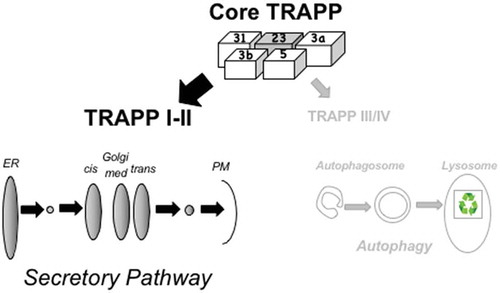Figures & data
Figure 1. A model explaining the reason for a severe autophagy defect in Trs23/TRAPPC4 mutant cells. Top: molecular architecture of the yeast core TRAPP (TRAPP I), which contains four subunits (3a and 3b, two copies of Bet3; 5, Bet5; 31, Trs31; 23, Trs23). TRAPP II–IV complexes contain core TRAPP and additional complex-specific subunits. Mutant Trs23/TRAPPC4 result in a low level of this core TRAPP subunit and the core TRAPP complex. Because the secretory pathway (left) is important for cell viability under normal growth conditions, we propose that most of the available core TRAPP is shuttled to this process by assembling TRAPP complexes required for secretion (i.e., TRAPP I–II). Consequently, less core TRAPP is available for assembly of TRAPP complexes needed for autophagy (right; i.e., TRAPP III–IV). This, in turn, results in a severe autophagy phenotype. ER, endoplasmic reticulum; PM, plasma membrane.

